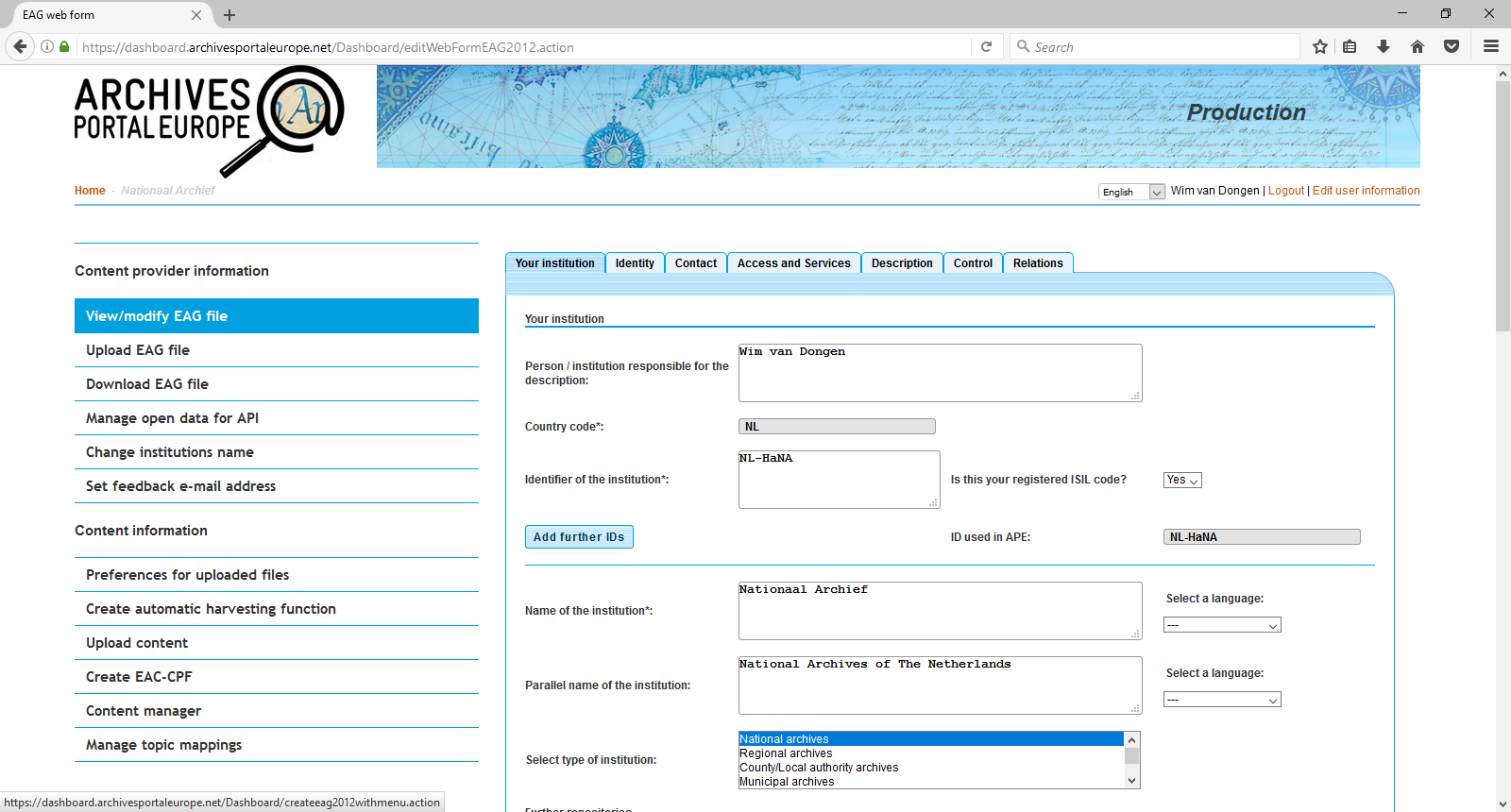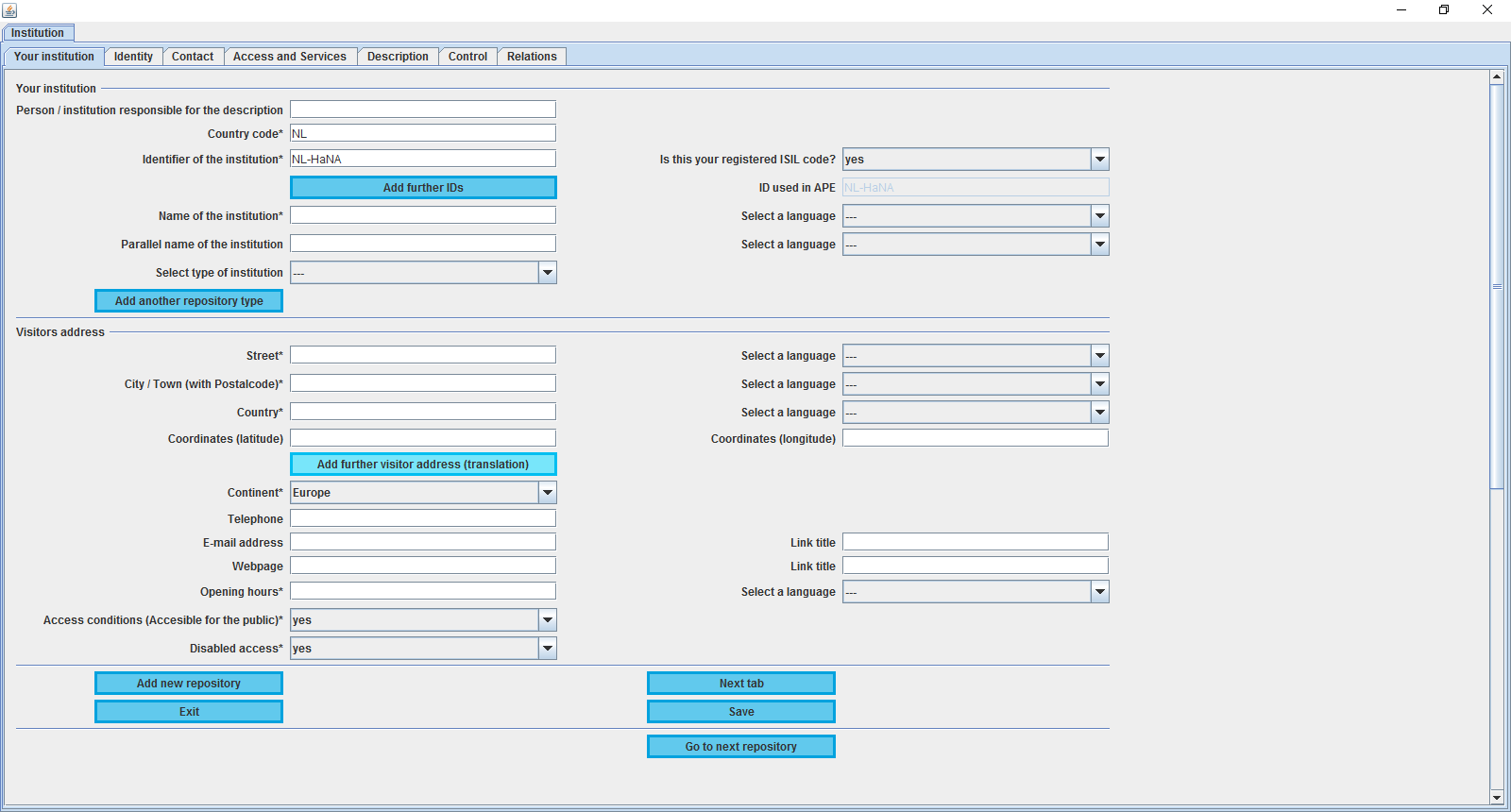Difference between revisions of "EAG2012"
| Line 1: | Line 1: | ||
| − | |||
= Describing archival institutions using Encoded Archival Guide (EAG) = | = Describing archival institutions using Encoded Archival Guide (EAG) = | ||
The Archives Portal Europe provides comprehensive information about institutions with archivals holdings in the "[https://www.archivesportaleurope.net/directory Directory]". Often the self-description of an institution is the first step to become visible in the European archival landscape, even without having archival descriptions online. The description of an archival institution is encoded in EAG/XML. The Archives Portal Europe enables content providers to create EAG/XML files within the provided tools: the Dashboard and the Data Preparation Tool (DPT). | The Archives Portal Europe provides comprehensive information about institutions with archivals holdings in the "[https://www.archivesportaleurope.net/directory Directory]". Often the self-description of an institution is the first step to become visible in the European archival landscape, even without having archival descriptions online. The description of an archival institution is encoded in EAG/XML. The Archives Portal Europe enables content providers to create EAG/XML files within the provided tools: the Dashboard and the Data Preparation Tool (DPT). | ||
| Line 5: | Line 4: | ||
[[File:EAG2012_01.png|600px|thumb|left|APE Dashboard: form for creating an EAG2012/XML file]] | [[File:EAG2012_01.png|600px|thumb|left|APE Dashboard: form for creating an EAG2012/XML file]] | ||
<br clear=all> | <br clear=all> | ||
| + | For more information on how to create an EAG2012/XML file in the Dashboard, see the manual. | ||
[[File:EAG2012_02.png|600px|thumb|left|APE DPT: option for creating an EAG2012/XML file]] | [[File:EAG2012_02.png|600px|thumb|left|APE DPT: option for creating an EAG2012/XML file]] | ||
<br clear=all> | <br clear=all> | ||
| + | For more information on the free downloadable APE Data Preparation Tool (DPT), see the manual. | ||
| − | This page | + | This page gives access to information on the XML standard Encoded Archival Guide (EAG) in its version of 2012, which has been developed within the APEx project in the context of expanding and enhancing the Archives Portal Europe. EAG2012, forthwith referred to as EAG, is the result of reviewing the existing version EAG 0.2, created initially in the context of the [http://censoarchivos.mcu.es/CensoGuia/portada.htm Censo-Guía de los Archivos de España e Iberoamérica], and relating this to the International Standard for Describing Institutions with Archival Holdings ([http://www.ica.org/en/isdiah-international-standard-describing-institutions-archival-holdings ISDIAH]) as published by the International Council on Archives (ICA). |
<br/> | <br/> | ||
| − | + | ||
* The page on "[http://www.archivesportaleuropefoundation.eu/images/docs/EAG2012_DescribingInstructions.html Describing institutions]" defines the information recommended to be given and provides constituent examples according to the elements of ISDIAH. | * The page on "[http://www.archivesportaleuropefoundation.eu/images/docs/EAG2012_DescribingInstructions.html Describing institutions]" defines the information recommended to be given and provides constituent examples according to the elements of ISDIAH. | ||
* The "[http://www.archivesportaleuropefoundation.eu/images/docs/EAG2012_TagLibrary.html Tag library]" shows how such information is to be encoded in EAG. | * The "[http://www.archivesportaleuropefoundation.eu/images/docs/EAG2012_TagLibrary.html Tag library]" shows how such information is to be encoded in EAG. | ||
Revision as of 10:52, 9 February 2017
Describing archival institutions using Encoded Archival Guide (EAG)
The Archives Portal Europe provides comprehensive information about institutions with archivals holdings in the "Directory". Often the self-description of an institution is the first step to become visible in the European archival landscape, even without having archival descriptions online. The description of an archival institution is encoded in EAG/XML. The Archives Portal Europe enables content providers to create EAG/XML files within the provided tools: the Dashboard and the Data Preparation Tool (DPT).
For more information on how to create an EAG2012/XML file in the Dashboard, see the manual.
For more information on the free downloadable APE Data Preparation Tool (DPT), see the manual.
This page gives access to information on the XML standard Encoded Archival Guide (EAG) in its version of 2012, which has been developed within the APEx project in the context of expanding and enhancing the Archives Portal Europe. EAG2012, forthwith referred to as EAG, is the result of reviewing the existing version EAG 0.2, created initially in the context of the Censo-Guía de los Archivos de España e Iberoamérica, and relating this to the International Standard for Describing Institutions with Archival Holdings (ISDIAH) as published by the International Council on Archives (ICA).
- The page on "Describing institutions" defines the information recommended to be given and provides constituent examples according to the elements of ISDIAH.
- The "Tag library" shows how such information is to be encoded in EAG.
- The EAG schema in formats XSD, RNC and RNG and xslt stylesheet to convert EAG 0.2 to EAG2012 can be downloaded over here:
- EAG2012 XSD schema (XSD schema file for EAG2012 as used for creation and validation in the Archives Portal Europe)
- EAG2012 rnc and rng (RNC and RNG files for EAG2012 (not official launched yet)
- EAG2012 stylesheet (XSLT stylesheet to convert EAG 0.2 to EAG2012)

